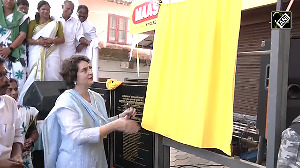Like on Pegasus, like Covid, there have been no answers from the government about why the situation on the economy and India's future is where it is today, notes Aakar Patel.

Till a few weeks ago, the issue dominating the media in India and for a few days even in the world was India's management of the pandemic.
Vaccines are still in short supply, as we are hearing daily from chief ministers, but for now the story is on the back burner.
Another has moved to the front burner and that is the Pegasus: The Israeli software the government purchased to spy on journalist, politicians, sexual harassment victims and their relatives and officers of the Central Bureau of Investigation.
Why did it do so? We do not know and will never be told.
India is democratic, but it is also opaque. The government is run like a kingdom and the elected leader does not need to respond to questions or hold press conferences.
Media that report the truth will be raided.
This column is not about the current story but one that has been on the back burner for the entire period of the Modi era.
It is about where we stand and what our future will be.
Like on Pegasus, like Covid, there have been no answers from the government about why the situation on the economy and India's future is where it is today.
But the facts cannot be hidden. Here they are and ask yourself at the end of it where you think India is today, and where it is being taken.
Spending on food by the poorest Indians had declined before the pandemic.
Consumer expenditure of Indians was lower in 2017-2018 than in 2011-2012. The data on this came from the government, but was not released.
Joblessness rose consistently under Modi. The total numbers of Indians with work shrank under Modi from 44 crore (440 million) in 2013 to 41 crore (410 million) in 2016 to 40 crore (400 million) in 2017 then to 38 crore (380 million) in 2021, though the workforce grew from 79 crore (790 million) to 106 crore (1.06 billion).
Consequently the Indian middle class stopped growing under Modi.
Residential sales in eight major cities (Ahmedabad, Bangalore, Chennai, Delhi, Hyderabad, Kolkata, Mumbai and Pune) remained stagnant from 3.3 lakh (330,000) units in 2012 to 3.2 lakh (320,000) in 2019. In 2020 they fell to 1.5 lakh (150,000) units.
Passenger vehicle sales remained stagnant for a decade, with sales of 27 lakh (2.7 million) in 2012, 27 lakh in 2019 and 27 lakh in 2020.
Two wheeler sales were stagnant at 1.6 crore (16 million) in 2014, 1.7 crore (17 million) in 2019 and 1.5 crore (15 million) in 2020.
Three wheeler sales were 5 lakh (500,000) in 2012, 5 lakh in 2015, 5 lakh in 2016, 6 lakh (600,000) in 2019 and 2 lakh (200,000) in 2020.
Commercial vehicles sales were stagnant at 7.9 lakh (790,000) in 2012, 6 lakh (600,000) in 2015, 7 lakh (700,000) in 2016, 7 lakh in 2019 and 5.6 lakh (560,000) in 2020.
The total Indian market for consumer durables (air conditioners, washing machines, television sets etc) was estimated in 2014 to be worth Rs 150,000 crore (Rs 1.5 trillion) by 2020. It was Rs 76,400 crore (764 billion) in 2019 and Rs 50,000 crore (rs 500 billion) in 2020.
Total passengers (rail plus air) fell from 840 crore in 2012 to 826 crore in 2019, and this is before the pandemic.
China's Premier Li Keqiang has developed an index which measures real GDP growth through three indicators: Railway cargo volume, electricity consumption and loans disbursed.
Total tonnes ferried by railways was 1.1 billion tonnes in 2014, 2015, 2016, 2017 and 2018.
It was 1.2 billion tonnes in 2019 and 1.2 billion in 2020.
Electricity generation remained at 1.3 billion units for four years in 2017, 2018, 2019 and 2020 while India's population grew by 7 crore people.
The growth of bank credit to industry fell from 15 per cent in 2013 to 12 per cent in March 2014, 5 per cent in 2015, 2.7 per cent in 2016, minus 1.7 per cent in 2017, 0.7 per cent in 2018 and 6.9 per cent in 2019.
Growth of credit to medium sized industries was minus 0.5 per cent in March 2014, 0.4 per cent in 2015, minus 7.8 per cent in 2016, minus 8.7 per cent in 2017, minus 1.1 per cent in 2018 and 2.6 per cent in 2019.
All this was before the pandemic.
Credit to micro and small industries grew minus 2.3 per cent in March 2016, minus 0.5 per cent in 2017, 0.9 per cent in 2018 and 0.7 per cent in 2019.
Before Modi, between 2009 and 2013, loans disbursed (non-food credit) had grown at an average of 17 per cent.
This then was the result of the performance of the Modi government.
Why has it come to this? What does our future hold?
How will we compete with the rest of the world and bring our crores out of poverty if we continue in this fashion?
We do not know and the government has no interest in either acknowledging that this is the state of affairs, or about responding to what it is doing about it.
It will deflect the current scandal and hope that it will ebb soon, just like the previous scandal ebbed.
Life will carry on. Sab changa si.
Aakar Patel is a columnist and writer and you can read Aakar's earlier columns here.
Feature Presentation: Aslam Hunani/Rediff.com











 © 2025
© 2025